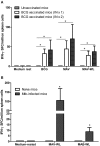BCG Vaccination Induces M. avium and M. abscessus Cross-Protective Immunity
- PMID: 30837992
- PMCID: PMC6389677
- DOI: 10.3389/fimmu.2019.00234
BCG Vaccination Induces M. avium and M. abscessus Cross-Protective Immunity
Abstract
Pulmonary non-tuberculous mycobacterial (NTM) infections particularly caused by Mycobacterium avium complex (MAC) and Mycobacterium abscessus (MAB) are becoming major health problems in the U.S. New therapies or vaccines which will help prevent the disease, shorten treatment duration and/or increase treatment success rates are urgently needed. This study was conducted with the objective of testing the hypothesis that Bacillus Calmette Guerin (BCG), a vaccine used for prevention of serious forms of tuberculosis (TB) in children and adolescents in tuberculosis hyperendemic countries, induces cross-protective T cell immunity against Mycobacterium avium (MAV) and MAB. Human TB and NTM cross-protective T cells were quantified using flow cytometric assays. The ability of BCG expanded T cells to inhibit the intracellular growth of MAV and MAB was assessed in co-cultures with infected autologous macrophages. In both BCG-vaccinated and M. tuberculosis (Mtb)-infected mice, NTM cross-reactive immunity was measured using IFN-γ ELISPOT assays. Our results demonstrate the following key findings: (i) peripheral blood mononuclear cells from TB skin test-positive individuals contain MAV and MAB cross-reactive T cells, (ii) both BCG vaccination and Mtb infection of mice induce MAV and MAB cross-reactive splenic cells, (iii) BCG-expanded T cells inhibit intracellular MAV and MAB, (iv) CD4, CD8, and γδ T cells play important roles in inhibition of intracellular MAV and MAB and (v) BCG vaccination of healthy volunteers induces TB and NTM cross-reactive T cells. In conclusion, BCG-vaccination induces NTM cross-reactive immunity, and has the potential for use as a vaccine or immunotherapy to prevent and/or treat pulmonary NTM disease.
Keywords: BCG; abscessus; avium; mycobacteria; nontuberculous.
Figures





Similar articles
-
Immunogenicity and vaccine potential of clinical isolate Mycobacterium kansasii strain against Mycobacterium tuberculosis infection.Microbiol Spectr. 2024 Aug 6;12(8):e0081924. doi: 10.1128/spectrum.00819-24. Epub 2024 Jul 9. Microbiol Spectr. 2024. PMID: 38980025 Free PMC article.
-
Oral Tolerance to Environmental Mycobacteria Interferes with Intradermal, but Not Pulmonary, Immunization against Tuberculosis.PLoS Pathog. 2016 May 6;12(5):e1005614. doi: 10.1371/journal.ppat.1005614. eCollection 2016 May. PLoS Pathog. 2016. PMID: 27153120 Free PMC article.
-
Dendritic cells induce CD4+ and CD8+ T-cell responses to Mycobacterium bovis and M. avium antigens in Bacille Calmette Guérin vaccinated and nonvaccinated cattle.Scand J Immunol. 2000 Sep;52(3):285-91. doi: 10.1046/j.1365-3083.2000.00780.x. Scand J Immunol. 2000. PMID: 10972905
-
Is interferon-gamma the right marker for bacille Calmette-Guérin-induced immune protection? The missing link in our understanding of tuberculosis immunology.Clin Exp Immunol. 2012 Sep;169(3):213-9. doi: 10.1111/j.1365-2249.2012.04614.x. Clin Exp Immunol. 2012. PMID: 22861360 Free PMC article. Review.
-
Natural and trained innate immunity against Mycobacterium tuberculosis.Immunobiology. 2020 May;225(3):151951. doi: 10.1016/j.imbio.2020.151951. Epub 2020 Apr 27. Immunobiology. 2020. PMID: 32423788 Review.
Cited by
-
Meeting the challenges of NTM-PD from the perspective of the organism and the disease process: innovations in drug development and delivery.Respir Res. 2022 Dec 24;23(1):376. doi: 10.1186/s12931-022-02299-w. Respir Res. 2022. PMID: 36566170 Free PMC article. Review.
-
Mycobacterium abscessus: It's Complex.Microorganisms. 2022 Jul 19;10(7):1454. doi: 10.3390/microorganisms10071454. Microorganisms. 2022. PMID: 35889173 Free PMC article. Review.
-
Alternatives to Antibiotics against Mycobacterium abscessus.Antibiotics (Basel). 2022 Sep 28;11(10):1322. doi: 10.3390/antibiotics11101322. Antibiotics (Basel). 2022. PMID: 36289979 Free PMC article. Review.
-
Effects of non-tuberculous mycobacteria on BCG vaccine efficacy: A narrative review.J Clin Tuberc Other Mycobact Dis. 2024 May 4;36:100451. doi: 10.1016/j.jctube.2024.100451. eCollection 2024 Aug. J Clin Tuberc Other Mycobact Dis. 2024. PMID: 38764556 Free PMC article. Review.
-
Paediatric cervicofacial lymphadenitis caused by non-tuberculous mycobacteria: nation-wide overview in the period 2000-2020.BMC Pediatr. 2025 Apr 2;25(1):270. doi: 10.1186/s12887-025-05603-x. BMC Pediatr. 2025. PMID: 40175984 Free PMC article.
References
Publication types
MeSH terms
Substances
Grants and funding
LinkOut - more resources
Full Text Sources
Medical
Research Materials

